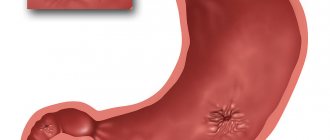The concept of lactostasis
During breastfeeding, complications with milk and stagnation in the breast may occur.
This condition is called lactostasis. When the ducts do not release milk for a long time, it leads to the formation of a milk plug. With a long-term inflammatory disease, purulent mastitis may occur. The disease begins in acute form a few days after childbirth, often in women who are not breastfeeding.
How to apply cabbage leaf for lactostasis?
The main folk remedy for lactostasis is cabbage leaf. There are several recipes:
- In the evening, place a whole leaf of cabbage over the area with the seal, put a bra on top or wrap your chest with a bandage so that the leaf does not slip off, and leave until the morning. The next evening use a new sheet;
- Prepare the cabbage leaf as in option 1, but additionally grease it with a mixture of salt and oil. Replace several times a day;
- Knead the cabbage leaf thoroughly with your hands or a rolling pin or beat it off, you can make several superficial cuts so that the leaf releases juice, apply a compress to the sore spot, securing it with a bandage. Change every 3 hours.
Perhaps a cabbage leaf will help you, but perhaps not, if all your treatment consists only of cabbage leaves. Therefore, first of all, focus on the main measures for lactostasis: pumping, massage and phonation.
Honey compresses
Traditional medicine suggests treating stagnation of breast milk by using honey compresses. There are quite a lot of recipes for their preparation; there are several general rules that are recommended to be followed:
- honey should be natural and, preferably, May honey;
- use honey heated in a water bath at a temperature of approximately 40°C;
- Regardless of the preparation method, the applied compress is distributed on the skin, covered with cellophane and insulated with a scarf or handkerchief;
- the duration of action of the honey compress is 3 hours;
- a honey compress is not always convenient, because... honey leaks out and stains clothes.
- In essence, the variety of methods for honey compress is the variety of “fillings” for cellophane:
- cabbage leaf with honey for lactostasis - smear a cabbage leaf with honey and apply it to your chest. Or apply a clean sheet to pre-lubricated skin;
- Grind the cabbage leaf in a meat grinder or blender, mix with honey in a ratio of 5:1;
- honey cake for lactostasis - prepare the mixture using equal amounts of honey and flour (rye or wheat), form it into a cake and apply to the stagnant area;
Please note that there is no scientific justification for the use of this drug for the treatment of lactostasis and information about the proven effectiveness of its use. Therefore, the use of honey compresses can only be considered as an additional and not mandatory remedy.
Prevention or how to avoid lactostasis during breastfeeding.
In order to maintain normal milk flow throughout the entire feeding period and prevent lactostasis, you need to adhere to a lifestyle that eliminates all causes (conditions, situations) that could cause stagnation.
A list of reasons was given at the beginning of the article. It's worth using it. For example, if we know that “regulated” feeding can lead to incomplete emptying of the breast, it is better to refuse it. Let the baby suckle when he is hungry, and not strictly every 3-4 hours. Let one feeding take as much time as the child needs, and not the “legalized” 15 minutes that someone once allotted him for this. Modern science believes that this approach is more justified and useful for the growth and development of the baby than the desire for a rigid regime.
So, prevention of lactostasis during breastfeeding:
- Feeding “on demand” without time limit.
- Avoid feeding in the same position.
- Make sure your baby grasps the nipple correctly.
- Do not use scissor finger positions during feeding.
- If there is enough milk and there are no signs of stagnation, then do not express too often.
- Strictly follow the “order” of breasts, keep a record.
- When the time comes to wean your baby, do it gradually.
- Periodically conduct preventive courses using the Vitafon device. Phonation perfectly maintains the normal state of muscle cell tone in the breast tissue, the walls of the milk ducts and blood microvessels and prevents the retention of milk on the outflow paths.
- Don't let your chest get cold. This is a very well-known rule among the people. Take all measures to avoid getting a chest cold.
- Give up the habit of sleeping on your stomach.
- Provide yourself with loose, comfortable clothing that does not restrict your chest.
During the period of breastfeeding, psycho-emotional stress, lack of sleep, and increased physical activity become an integral part of your life. And they are the real conditions for lactostasis. Let your loved ones do everything to save you from the influence of this negative triad: help, take on some of the worries, give you additional time for sleep and rest.
Conclusion
In conclusion, here are some basic recommendations for mothers who breastfeed their baby.
- Carefully analyze your lifestyle and immediately eliminate from it all potential causes of milk stagnation during breastfeeding. Carry out preventive procedures with the Vitafon device, preventing not only lactostasis, but also increasing the overall immunity of the body.
- If lactostasis does develop, do not delay taking measures to combat it: do not stop feeding, use the Vitafon device, express and massage the mammary gland (breast).
- In difficult cases, do not forget about professional medical help.
Main! Make every effort to continue breastfeeding your baby. This way you will create the best conditions for maintaining his health, successful growth and development.
FAQ:
Will a camphor oil compress help?
Answer: camphor oil for external use is a 10% solution of camphor in sunflower oil. It is used for rubbing for muscle pain, arthritis, rheumatism, etc. Camphor oil has no indications for use in lactostasis, but it is known that camphor interferes with the production of breast milk. In addition, this oil has a characteristic pungent odor, due to which the baby may simply refuse to breastfeed, while feeding cannot be interrupted during treatment.
Can I use an alcohol compress?
Answer: no. Alcohol inhibits the formation of oxytocin, which in the body of a nursing mother stimulates the outflow of milk. We also must not forget that alcohol can get into the milk, and therefore into the child’s body.
Is magnesium compress allowed?
It is not recommended to use a magnesium compress for lactostasis, since there is no information about the proven effectiveness of its use. At the same time, magnesium sulfate (magnesia) is contraindicated for breastfeeding when taken orally; there is always a possibility that the drug may enter the baby’s body during breastfeeding.
Will a bath help with lactostasis?
Answer: a bath is an intense thermal effect, both local (on the chest) and general (on the entire body). With local heat applied to the breast, the milk ducts expand and when expressing (right there, in the bath), the outflow of milk is facilitated. However, trying pumping in a bathhouse is permissible only if no more than 2 days have passed since the onset of signs of milk stagnation in a nursing mother and lactostasis occurs without fever. But even if you go to the bathhouse on the first “allowed” two days and you do not have a fever, you should always remember that the bathing procedure can be complicated by uncontrolled milk secretion, which will be very difficult to stop.
Is it possible to make compresses for lactostasis and fever in a nursing woman?
Answer: no. Compresses for lactostasis have warming properties; you can do them yourself 1-2 days from the beginning and only in the absence of fever.
Is it possible to use dimexide for lactostasis?
The only answer can be unequivocal - no. A drug such as dimexide is prohibited in pediatric practice due to its toxicity. Treatment with dimexide for lactostasis of the skin of the breast in a nursing mother leads to the entry of this substance into the child’s body and the implementation of its toxic effects.
How long does lactostasis last?
The duration ranges from one day to a week, then there is a possibility of lactostasis turning into serous mastitis.
Is no-spa used for lactostasis?
Indeed, no-shpa is sometimes used for milk stagnation, but it must be borne in mind that due to the lack of necessary clinical studies on the use of this drug during lactation, the use of no-shpa is not recommended.
How to break milk stagnation?
With lactostasis, in no case should you take any actions that could be characterized as hitting or breaking, as you can damage the mammary glands and greatly aggravate the situation. Only gentle massage and careful pumping are used.
I can’t express the stagnation of milk!
In response to this cry for help, a doctor must come. And before his arrival, you need to calm down and once again, after reading this article, make efforts, including with the help of your loved ones, to massage the breasts, pump, feed the baby and use phonation.
List of used literature:
- Ailamazyan E.K. Obstetrics: textbook. – Moscow State Medical University named after. THEM. Sechenov. – 9th edition, revised and expanded – Moscow: GOETAR-Media. – 2015
- Kildiyarova R.R. Nutrition for a healthy child. – 2nd edition, corrected and expanded – Moscow: GOETAR-Media. – 2015
- Kildiyarova R.R., Kolesnikova M.B. Pediatrician's Directory. – 3rd edition, corrected and expanded – Moscow: GOETAR-Media. – 2015
- Komarova T.A., Tulendiev T.V. A textbook of traditional medicine – Alma-Ata Publishing House: Kainar. – 1991
- Horse I.Ya. Nutrition for pregnant women, nursing mothers and young children. – Publishing house Medical Information Agency (MIA). – 2015
- Kostenko A. Smart herbs for your health. – AST Publishing House. – 2015
- Nikitin B.P. A healthy childhood without drugs or vaccinations. 6th edition, corrected and expanded - Publisher: List New Year. – 2001
- Pediatrics: national guidelines. – Moscow: GOETAR-Media, 2009
- Pediatrics - a textbook for medical universities / Edited by N.P. Shabalova. - Saint Petersburg. – 2003
- Pervushina E.N. Forest pharmacy. Medicinal plants. – Amphora Publishing House. – 2015
- Radzinsky V.E. Gynecology: textbook. – GOETAR-Media. – 2015
- Yakovlev Ya.Ya., Manerov F.K. Lactostasis and lactation mastitis in pediatric practice // Siberian Medical Review. – 2015 – No. 2 (92) – pp. 32-41.
- Feedback from the Research Institute of Obstetrics and Gynecology named after. BEFORE. OTTA dated December 16, 1997 No. 218 on the use of the Vitafon vibroacoustic device in the treatment of lactostasis and serous mastitis.
Author of the article: Candidate of Medical Sciences, doctor of clinical laboratory diagnostics Ionicheva L.V. (Penza)
You can ask questions (below) on the topic of the article and we will try to answer them competently!
Symptoms
The onset of the disease can be determined by the woman’s condition. To do this, identify signs of lactostasis in a nursing mother:
- the mammary gland becomes sensitive and hurts;
- there are noticeable lumps in the breasts that do not decrease during pumping;
- in places of compaction there may be reddened areas of skin;
- discomfort or pain occurs during or after the breast is emptied of milk;
- The temperature may rise with lactostasis, a feeling of weakness and chills may occur.
The mother's body prepares for feeding throughout pregnancy. There is a gradual development of alveolar tissues and milk ducts. Lactocytes—cells that secrete milk—grow. Prolactin accumulates, which is responsible for the lactation process.
The feeding mechanism starts only at the moment when the baby is born and the placenta is separated. Due to the fact that the level of progesterone sharply decreases and prolactin increases, dysfunction of the mammary glands occurs.
Important! Timely application is very valuable, it helps to avoid problems with swelling of the mammary glands. It is important to start breastfeeding correctly immediately after birth and encourage the child’s demands to breastfeed.
It is necessary to organize the correct feeding technique. The mother should have a comfortable position, the baby should touch her breast with his chin, opening his mouth wide and capturing most of the areola. Improper latch can cause swelling of the mammary glands.
Why is the occurrence of lactostasis dangerous?
A woman's breast milk is rich in nutrients. This is an ideal food not only for the baby, but also for numerous microorganisms. Stagnation of milk creates optimal conditions for the life and reproduction of bacteria. In response to the introduction of “strangers”, inflammation develops in the chest - mastitis.
The mammary gland increases in size, pain increases, swelling and redness appear on the skin, body temperature rises, and general health worsens. If measures are not taken in time, a cavity with pus will form in the chest - an abscess. It can only be cured by surgery.
In order to avoid such bleak prospects, treatment should begin as soon as the first symptoms of lactostasis appear. Visit a mammologist. Fortunately, coping with milk stagnation is often not difficult.
Causes of lactostasis
There are a number of anatomical reasons why lactostasis may occur in a nursing mother: for example, flat nipples. Having excluded anatomy, there are factors that can also contribute to the development of lactostasis:
- as a result of physical pinching. May occur when sleeping on your stomach, wearing a tight bra, or holding your breasts with your fingers while feeding;
- with insufficient release of milk from the breast. Lactostasis in a nursing mother can occur due to improper latching of the breast, irregular latching, sagging of the lower part of the breast;
- due to narrow ducts in the mammary gland;
- due to excessive milk production by the mammary glands;
- as a result of dehydration;
- due to fatigue, stress, overwork;
- due to bruises or chest injuries;
- as a result of hypothermia or exposure to a draft.
Complication
The most severe complication of lactostasis is mastitis - inflammation of the breast tissue. Patients experience increasing pain syndrome. Later it is accompanied by fever and increased temperature in the affected area. The skin of the mammary glands becomes covered with red stripes. Milk contains impurities of blood and purulent discharge.
The occurrence of mastitis is promoted by hypothermia (lactation in a cool room or in a draft) or overheating (hot shower, sauna) of the patient. Advanced lactostasis, complicated by mastitis, often causes the formation of a breast abscess.
Treatment of lactostasis
Analyzing traditional methods of relieving lactostasis, they note that for the most part they are ineffective. The effect of physiotherapy is weak, no-spa injections and warm compresses give little result. The use of massage and rough pumping by inexperienced medical professionals can lead to even greater engorgement of the mammary glands.
Qualified doctors working in our clinic are able to help with lactostasis with high-quality and truly helpful methods. With the use of special medications, relief occurs in a short time. When the pain subsides, you can begin to gently pump. After an hour, you can put your baby to your breast again. After feeding, cold applications can be applied; they will lead to a decrease in milk production.
For convenient expressing, you should use a breast pump. Before doing this, gently massage your breasts and begin the process. It is known that by carefully expressing milk, you can stimulate the production of even more milk. That is why, with lactostasis, expressing to the last drop is harmful. You need to release the breasts to a comfortable state.
Important! If after some time there is no positive effect, it is necessary to perform an ultrasound of the mammary glands again. In some cases, it will be necessary to take a needle biopsy of the diseased area of the breast. Then treatment with medications should be continued, and if there are special indications, breastfeeding should be discontinued.
Cost of services in mammology and physiotherapy
| Name of service | price, rub. |
| Consultation with a mammologist | 2000 |
| Hirudotherapy, up to 5 leeches | 2750 |
| Laser therapy, magnetic laser therapy (for fibrocystic mastopathy) | 1400 |
| Ultrasound therapy with medication | 1200 |
| Short ultraviolet radiation for lactostasis | 4000 |
If you cannot cope with lactostasis on your own, do not wait for it to lead to mastitis and abscess. Make an appointment with a mammologist: +7 (495) 120-08-07.
Prevention methods
It is necessary to prevent the occurrence of lactostasis not only because of the discomfort, but also because it can lead to the formation of mastitis in the future. To prevent this from happening, you need to:
- make breastfeeding very frequent, do not limit feeding and offer the breast when the baby demands. He should spend as much time at the breast as he wants. If there is a lot of milk that has stagnated, it is uncomfortable for him to latch onto the breast;
- look for positions that are comfortable for feeding, and if necessary, constantly change them. The baby should have access to milk from all parts of the breast;
- there is no need to squeeze the breasts too much during feeding to prevent blockage and compaction;
- try to avoid sleeping on your stomach, preferably sleeping on your side or back;
- it is important to choose the right bra so that it does not squeeze the chest and does not cause discomfort;
- avoid injury and hypothermia of the chest.
The above measures will help in the prevention of lactostasis. Preventing a disease is much better than fighting it in the future. This is why visiting a doctor in a timely manner is extremely important. You can make an appointment with our doctors online on the clinic’s website. It shows the opening hours and addresses of all six clinics. Among them, it is easy for the client to choose the one that will be more convenient to get into. To contact representatives of the clinic, there is a single number +7 495 790-35-53. By contacting it, you can ask your questions.
Preventive measures
- Put your baby to the breast as often as possible - practice feeding on demand, not according to a schedule.
- Do not pump after feedings unless necessary.
- Feed in different positions.
- Don't get too cold.
- At the first suspicion of lactostasis, seek advice from a specialist.
In the first week after birth, fluid intake (including first courses and fruits) may not be very large, unless there are separate indications for this - up to approximately 800-1,000 ml per day.
If you nevertheless suspect that you have lactostasis, then the first thing you need to do is put your baby to your breast. If the stagnation is small, the baby can resolve it. Experts recommend that if lactostasis occurs, offer the baby a painful breast every hour and keep him there for as long as possible.
If the baby refuses, you can resort to pumping, manual or machine, but be sure to let the baby suck out the remaining milk after that.







